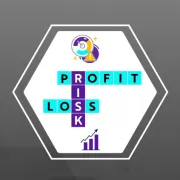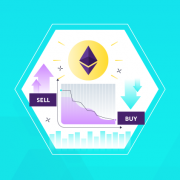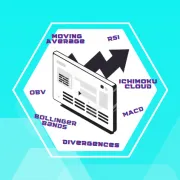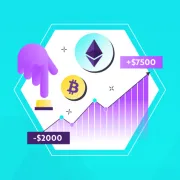One of the most crucial aspects of making a trade is determining the price levels at which the buying and selling of security will occur. Many traders use one of two methods to make this decision: The market order or limit order. In this piece, we will be diving into the order types, the difference between market and limit order, and how to use them.
Article summary
What is an order book?
Before diving into understanding the two different types of orders mentioned above, let’s get first a basic understanding of what an order book is. An order book is an electronic or manual list that shows the level of interest that investors have in a particular asset.
When a trader seeks to execute a trade, they could request from a broker the need to trade an asset. That request is known as an order. When that order is made, it is then put in an order book. This order book contains a list of requests made by other traders for an asset. They are also arranged according to price levels. An order is known to be open if its trades have not been executed. Meanwhile, an order is closed if its trades have already been executed.
What is a limit order?
A limit order is an order type where trade is only executed when an asset reaches a specific price. This type of order has released traders from a bit of restriction. Traders now have the liberty to decide the price they would like to buy or sell an asset.
Unlike market orders, limit orders are not executed immediately. An order will only be executed when the target price is attained. They are suited for assets that are thinly traded and very volatile. Limit orders help to reduce risks that could come with such assets.
A big downside to limit orders is that some orders might never be executed. If a trader has set their limit price on an asset and it never reaches that price point, execution will not be possible.
How does a limit order work?
If a trader wants to buy an asset, they can set a limit for the price they are willing to buy that asset. If the price reaches or falls below that point, the trade is executed. This is otherwise known as buy limit order.
Conversely, a trader interested in selling an asset at a higher price can set a limit to how much they are willing to sell the asset. Hence, if the price reaches or rises above the targeted price point, execution will occur. This is otherwise known as sell limit order.
Let’s assume you want to buy the shares of X Company. But you feel the price of $240 is too high. Although you are still interested in buying the shares and will be willing to purchase them at $200. You can set a limit order so if the prices of the shares reach $200, you can purchase them. But keep in mind that if the shares do not reach that price point, the trade will not be executed. So you may need to monitor your open order and adjust the level according to market fluctuation.
What is a market order?
A market order is an immediate order which is placed to trade an asset at a market’s current price. Simply put, you will pay close to or the requested ask when you want to buy a stock. Conversely, you will receive close to or the required bid when you want to sell a stock. This type of order is for people who are ready to buy or sell a stock at a given moment. Market orders are mostly preferred for trading assets that have good liquidity.
Market orders are the fundamental order type used in trading. This is because trade executions are instant and straight to the point. Many investors opt for market orders which is why there are always available buyers and sellers.
Although they have their advantages, a market order can be unfavorable for a few reasons. The volatility of assets plays a major role in the stock market, and it could work either to the advantage or disadvantage of a trader. In the case of market order, volatility can cause great disappointment when buying or selling an asset.
While executing a trade, there is a short time interval from when the trader hits the “buy/sell” button, to when the trade gets executed. During that time frame, stock prices could skyrocket or experience a massive dip. Assume a trader wants to buy an asset for $1000 when he hits the buy button. During the short time frame to get it executed, the price of the asset could increase to $1050. Hence, the trader ends up buying it for more than the previous market price. This happens more often in asset categories like Crypto where liquidity is not always the best for specific assets.
How does a market order work?
In the order book, pending limit orders are arranged according to price. The best ask price is the first in the Sell area of the book. While the best bid price is the first in the Buy area of the book. Obviously, the rate at which an order is executed depends on the price a trader pays. Orders with the best prices automatically get executed first.
When a Market Order is sent to the Exchange, it gets executed according to each side of the Order book. If the Market Order is a Buy order, then it takes from the Order Book the first best asks, until it fills the volume it wants to trade. Same goes for a Sell order, it takes from the Order Book the first best bids from the Buy area.
Difference between market order and limit order
Even though market orders and limit orders share great value to various traders, they are still widely dissimilar. One might ask: How are market orders and limit orders different? Well, we will be analyzing that in this piece:
- Speed of execution: Market orders are executed immediately and are suited for buyers and sellers that are ready to trade in an instant. Meanwhile, limit orders are executed only when the target price is attained.
- Asset types: Market orders are mostly executed on assets of large caps and good liquidity. Even with their size, market orders offer the ease of quick trade execution. Meanwhile, limit orders are mostly executed on thinly traded assets. This is because they possess high volatility. Hence, limit orders help to gauge that volatility and limit risks.
How to use limit order and market order in crypto markets?
It is obvious that both order types are suited for their specific types of traders, and the types of assets traded. This is why you should know how to use either the crypto market order or the crypto limit order. You should also understand the right moments and situations to use them.
Here is how to use a crypto market order:
- You should use a market order when you want to sell or buy an asset immediately. If you are fine with the current market price and willing to make your trade at all costs, the market order is the best option.
- Market orders are also an amazing option for assets of high liquidity. It is also beneficial when the bid-ask spread of the asset you are trading is significantly low.
Here is how to use a crypto limit order:
- You should use a limit order when you have a specific price in mind. If you feel like the value of that asset would reach a certain price level, then you can go ahead.
- Unlike market orders, limit orders are better for illiquid assets. Also, they can be very helpful if you want to trade a large number of shares.
How do market order and limit order work in Vestinda strategies?
Order types are essential to the performance of your trades. This is why it is important to be well-informed on different order types before executing a trade.
While using automated strategies with Vestinda to improve your trading experience and save time, you can choose to either use LIMIT or MARKET orders when the platform is placing the orders.
A LIMIT order is used to buy or sell at a predetermined price and will not execute unless the price meets those qualifications. The price determined by the platform is one that goes in the Order Book in front of all the other orders that exist already. For example, if a new long Position is being opened then the LIMIT order will be sent to the Exchange with a price between the best bid and the best ask price, closer to the best bid.
A MARKET order is trying to find the right price in the Order Book to increase chances of getting filled.

Ebiere Watchman is a prolific writer specialized in web 3.0 and finance. Ebiere’s experience includes research projects, sales copywriting, and storytelling. She prides herself in crafting impeccable content to drive mass adoption in cryptocurrency.






